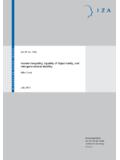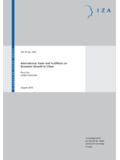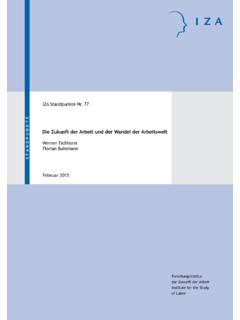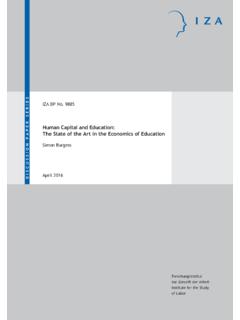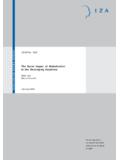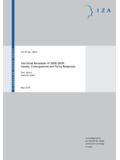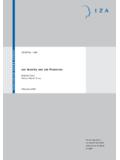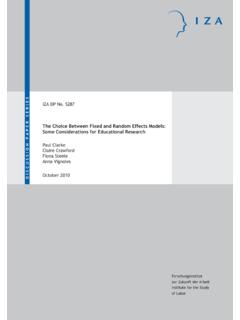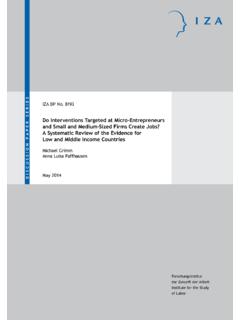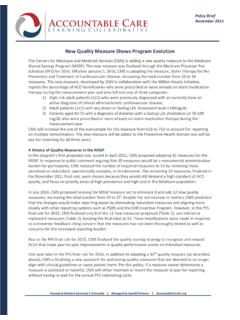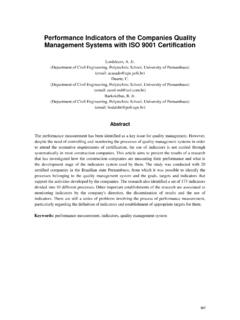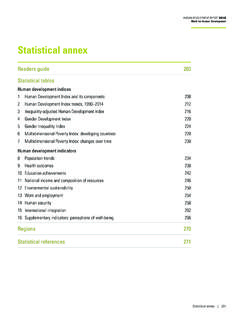Transcription of Tertiary Education and Prosperity: Catholic Missionaries ...
1 Forschungsinstitut zur Zukunft der ArbeitInstitute for the Study of Labor DISCUSSION PAPER SERIEST ertiary Education and prosperity : Catholic Missionaries to luminosity in IndiaIZA DP No. 9441 October 2015 Amparo Castell -ClimentLatika ChaudharyAbhiroop Mukhopadhyay Tertiary Education and prosperity : Catholic Missionaries to luminosity in India Amparo Castell -Climent University of Valencia Latika Chaudhary Naval Postgraduate School Abhiroop Mukhopadhyay Indian Statistical Institute and IZA Discussion Paper No. 9441 October 2015 IZA Box 7240 53072 Bonn Germany Phone: +49-228-3894-0 Fax: +49-228-3894-180 E-mail: Any opinions expressed here are those of the author(s) and not those of IZA. Research published in this series may include views on policy, but the institute itself takes no institutional policy positions.
2 The IZA research network is committed to the IZA Guiding Principles of Research Integrity. The Institute for the Study of Labor (IZA) in Bonn is a local and virtual international research center and a place of communication between science, politics and business. IZA is an independent nonprofit organization supported by Deutsche Post Foundation. The center is associated with the University of Bonn and offers a stimulating research environment through its international network, workshops and conferences, data service, project support, research visits and doctoral program. IZA engages in (i) original and internationally competitive research in all fields of labor economics, (ii) development of policy concepts, and (iii) dissemination of research results and concepts to the interested public.
3 IZA Discussion Papers often represent preliminary work and are circulated to encourage discussion. Citation of such a paper should account for its provisional character. A revised version may be available directly from the author. IZA Discussion Paper No. 9441 October 2015 ABSTRACT Tertiary Education and prosperity : Catholic Missionaries to luminosity in India* This paper estimates the causal impact of Tertiary Education on luminosity across Indian districts. We address the potential endogeneity of Tertiary Education using the location of Catholic Missionaries in 1911 as an instrument for current Tertiary Education . We find Catholic Missionaries have a large and positive impact on Tertiary Education . Catholics were not at the forefront of Tertiary Education in colonial India, but they established many high quality colleges following Indian independence.
4 Controlling for a rich set of geographical and historical characteristics, we find a positive causal effect of Tertiary Education on development, as measured by light density at night. The findings are robust to different measures of development, and are not driven by alternative channels through which Missionaries could impact current income. JEL Classification: I25, N35, O15 Keywords: human capital, Catholic Missionaries , subregional analysis Corresponding author: Abhiroop Mukhopadhyay B 10 Indian Statistical Institute 7 Sansanwal Marg New Delhi 110016 India E-mail: * We would like to thank participants at the Xth Annual Conference on Economic Growth and Development, World Economic History Congress, Stanford Institute for Theoretical Economics Conference, ANAECO Workshop, and seminar participants at UNSW(Sydney), Monash University (Melbourne), Delhi School of Economics and CMI (Bergen) for their positive feedback.
5 We are grateful to Federico Mantovanelli for sharing the historical maps and to Romain Wacziarg for his comments. This work would not have been possible without the effort put in by Athisii Kayina. We acknowledge the financial support from the Spanish Ministry of Economy and Competitiveness through ECO2011-29283 project, and the Planning and Policy Research Unit at the Indian Statistical Institute (Delhi). The views expressed in this article are those of the authors and do not reflect the official policy or position of the Department of Defense or the Government. 1 IntroductionIdentifying the fundamental determinants of development has a long pedigree in large literature relying largely on cross-country variation has emphasized the role ofinstitutions (Acemoglu et al.)
6 , 2001, 2002, 2014), geography (Sachs 2003), openness totrade (Frankel and Romer 1999), and human capital (Lucas 1998). Among these factors,the empirical evidence linking Education to income has produced perhaps the weakestfindings at the macro level (Benhabib and Spiegel 1994). The lack of a robust relationshipbetween Education and income is at odds with the vast labor literature, whichfinds strongcausal effects of each additional year of schooling on individual earnings on the order of10 to 15% across a wide set of countries (Card 2001). How do we reconcile the two setsoffindings?One explanation is perhaps that the macro literature has relied on incorrect measuresof Education . Most of the literature uses average years of schooling to capture educationdifferences across countries (see Benhabib and Spiegel 1994; Cohen and Soto 2007; de laFuente and Dom nech 2007).
7 The large number of people with no Education skew averageyears of schooling for poor countries. Moreover, primary Education is often of poor qualityin these countries (Chaudhury et. al 2006), further exacerbating measurement may explain why years of Education correlate poorly with economic outcomes at themacro level (Pritchett 2001). Another mutually nonexclusive explanation is the focus oncross-country analysis. The vast differences in culture, institutions and access to technol-ogy make it difficult to identify the causal effect of Education on income. Problems ofomitted variables and reverse causality plague many of the empirical studies (Acemogluet al. 2014).In this paper, we study the impact of Tertiary Education on development using dataon Indian districts in 2006. The focus on a single country minimizes concerns of omittedvariables because these sub-national units atleast share common governance and nationalpolicies.
8 Our focus on districts, an administrative unit below states, thus allows for tightcomparisons because we exploit differences across districts within the same state usingstatefixed effects. This strategy allows us to address Acemoglu et al s (2014) concerns- thatempirical studies treating institutions and human capital as exogenous are institutions are mainly determined at the central and state level, the advantageof this approach is we can account for institutions without the need of an , district-level data pose one problem in the Indian context - current incomelevels are not well measured. We address this shortcoming by using night lights dataas a proxy for income, in line with the recent literature (see Henderson et al. 2012;Micholapoulos and Papaioannou 2013, 2014; Alesina et.)
9 Al. 2012). We rely on informationcollected by the National Geophysical Data Center (NGDC) on the location of night lightsbetween 8pm and 10pm, as captured by satellites of the United States Air Force DefenseMeteorological Satellite Program (DMSP). Observations are available for an area of onesquared kilometer and can be aggregated to the district level. To measure human capital,we focus on the share of the adult population with Tertiary Education , as only higher levelsof Education appear to be correlated with economic growth in India ( Castell -Climentand Mukhopadhyay 2013).Wefind a strong positive association between the share of the population with ter-tiary Education and light density at night in an OLS model that controls for statefixedeffects. This relationship is robust to a rich array of factors that may jointly influencetertiary Education and luminosity such as current population, population shares of sociallydisadvantaged groups , geographical characteristics, and historical variables that serve asinitial states.
10 The potential endogeneity of Tertiary Education , however, poses an empir-ical challenge because Tertiary Education andthe evolution of income generally go handin hand. We address this concern by using exogenous variation generated by the locationof Catholic Missionaries as of the early 20thcentury to instrument for current tertiaryeducation. Using thefirst edition of the ,weextracttheexactge-ographical location of Catholic Missionaries in 1911 and overlay the historical maps ondistrict borders as of 2001 using a geographic information system (GIS) location of Catholic Missionaries has to satisfy two conditions to be a valid in-strument. First, the location of Catholic Missionaries has to be unrelated to any factorthat may impact the subsequent development of districts other than through current ter-tiary Education .
